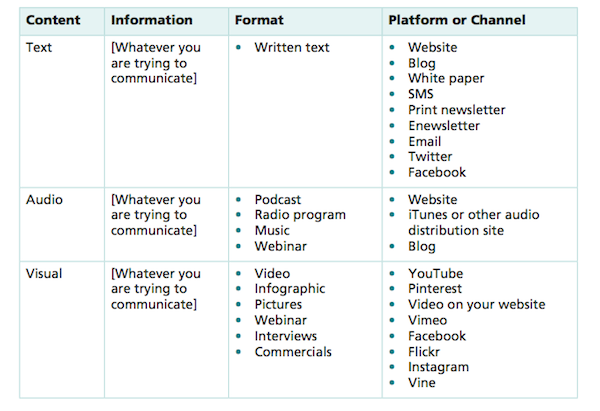“Content Formats that Flex” is an excerpt from chapter three of The Digital Crown: Winning at Content on the Web.
We choose content formats in our own lives, often without thinking about it. Let’s say you receive an email from a colleague.
You read it, realize it’s a sensitive or complicated issue, and think, “I should really call this person back, not email him.”
You realize that the information you need to communicate may not be appropriate for an email.
That is an automatic, gut response; you probably don’t realize how you are flexing from one mode of communication to another, even as you are doing it. We choose which platform of technology is best to communicate our message; in other words, which content format works best—in this case written versus verbal.
Do you text or call a friend to let him or her know what time you will be at the restaurant? Think about it—you could call, but you know that will take longer than texting. The “Hi, how are you?” turns into a longer, perhaps unnecessary, conversation when all you really want to do is convey the information that you will be there at 6:00 p.m.
Recognizable Formats Attract Attention
We also exercise this flexibility when we choose, for example, to write a press release rather than a blog post. You write a press release because you know journalists immediately recognize a press release as a content format designed just for them. The format of the content communicates whom it is for immediately.
We don’t want our content and our conversations to feel like the Room of Requirement
Our audience has thousands of immediately recognizable content formats to look for/recognize/react to: Stop signs, customer reviews, prescription pads, report cards, medical forms, applications, and so on. Designed so we immediately recognize them and take certain actions, these content formats facilitate crisper interactions. Imagine the Internet without content formats? Overwhelming as it is now, it would be totally unnavigable.
THAT is our goal: We want our audience to immediately recognize the content, know it is for them, know what to do, and do it.
We don’t want our content and our conversations to feel like the Room of Requirement. We want the very opposite, in fact. We want them to feel like controlled experiences that help customers make decisions.
Content: Formats, Platforms, and Channels
There are probably hundreds of formats for content—there is no way we could list them all here. For the purposes of your content framework, however, I think we can look at the following divisions:
- Text
- Audio
- Visual
In the following table, we differentiate information from content format, platform, and channel:
When you talk to people about content, they think you mean their website, as in the entire thing. But, as we know, content is not the website, it is what is ON the website, or in the book, or the subject of the video. You need to disassociate this idea that content is the same as the way it’s delivered to you. Content is not a magazine, or a TV program, or the mail. Rather, those are the channels through which you receive the content.
Your customers can encounter your content anywhere on the World Wide Web. You must divorce yourself from the idea that your content is tied to its point of origin—like your website—and instead think of your content as floating throughout the Internet, just waiting to fulfill a need for your target audience.
To read about all of the aspects of creating content experiences that wins with users, pick up a copy of The Digital Crown, using the discount code “SAVE3012” for 30% off the list price.








